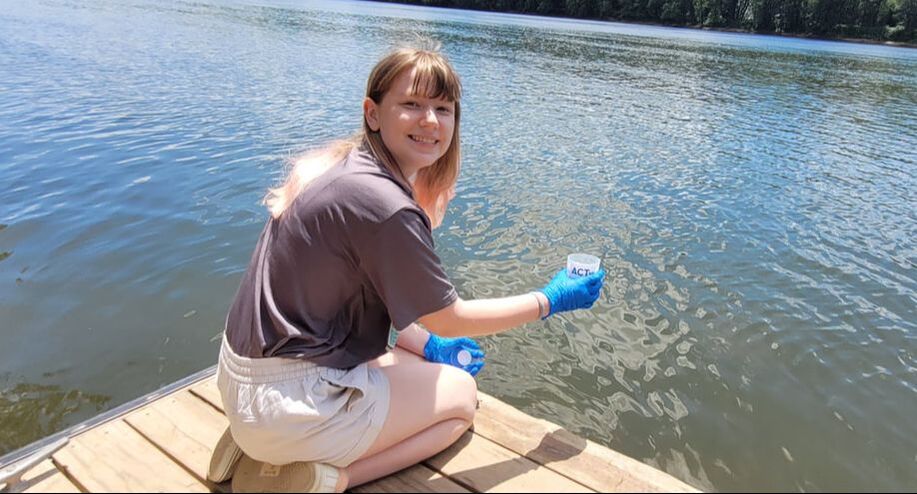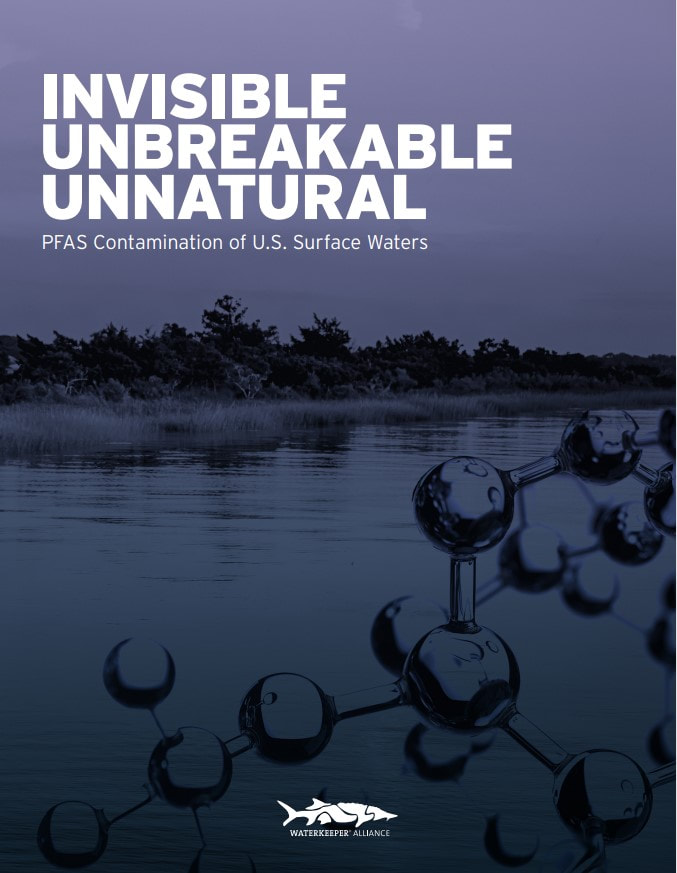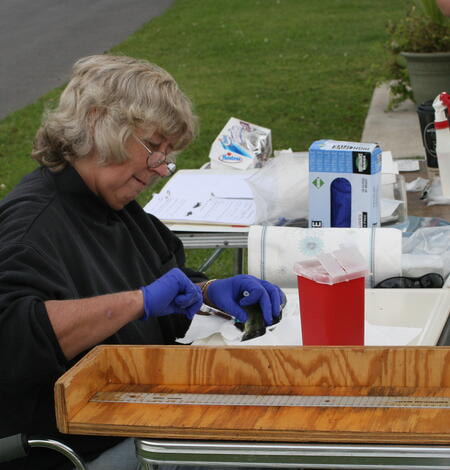 Middle Susquehanna Riverkeeper Association summer intern Peyton Curley collects a water sample at Greevy Boat Launch along the West Branch of the Susquehanna River just below Williamsport in late June. The sample was part of a nationwide PFAS testing program with the Waterkeeper Aliance and Cyclopure. Elevated levels of certain PFAS compounds were found in the Williamsport area of the West Branch of the Susquehanna River as part of a groundbreaking new analysis of American waterways released today (Oct. 18, 2022). The study sounds the alarm on a PFAS pollution emergency via the report titled Invisible, Unbreakable, Unnatural: PFAS Contamination of U.S. Surface Waters. PFAS are a group of manmade chemicals that all share some sort of fluorinated compound. These per- and polyfluoroalkyl substances are widely linked to serious public health and environmental impacts and more commonly called "forever chemicals." In late June, the Middle Susquehanna Riverkeeper Association collected an upstream sample from the deck of the Hiawatha Paddleboat at its dock just above the city and a downstream sample from the Greevy Boat Ramp as a part of a nationwide PFAS testing program conducted by the Waterkeeper Alliance and Cyclopure laboratories. Out of 114 waterways tested across the country, 83 percent were found to contain at least one type of PFAS compound.
“There are many other potential sources, and from such a wide variety of places, they get into our ground and surface water systems, and people can be exposed to them there or even through the food they eat or the air they breathe.”
Other known sources for PFAS-related compounds include stain-resistant products, paints, pesticides, certain shampoos and other personal care products, photography products, chemicals used for mining and drilling and various polishes. What effects can they have? While much of this research is still ongoing, according to Blazer, PFAS effects have been monitored in labs mostly on rats and mice and aquatically in certain model fish species. “They have shown a wide range of effects, including lipid metabolism, which can be related to obesity. There have also been some neurological effects, some cancers and some developmental impacts,” she said. “Another major effect in humans can be on the immune system. We have found a connection between totals PFAs concentrations and impacts on lymphocytes, which are cells that are associated with producing antibodies – like when you get a vaccine – and are important in killing virally infected cells.” In addition, PFAS in certain testing has been related to hypertension in pregnant women, kidney and testicular cancers, high cholesterol and thyroid disease. Levels near Williamsport The PFAS contaminant PFHpA, or perfluoroheptanoic acid, was found in 1 part per trillion (ppt) at the Hiawatha dock, but below detection standards at Greevy Boat Launch, indicating a source for this compound above the Hiawatha. According to the Human Toxome Report, PFHpA is a “breakdown product of stain- and grease-proof coatings on food packaging, couches and carpets.” There are currently no restrictions on this compound’s production and use in the U.S. PFHxA, or perfluorohexanoic acid, was found at a level of 1 ppt upstream and 1.3 ppt downstream. It is also used as a stain- and grease-proof coating on food packaging as well as in various other household products. There are currently no restrictions on this compound’s production and use in the U.S. PFOA, or perfluorooctanoic acid, was found at a level of 1 ppt upstream and 1.1 ppt downstream of the city. PFOA are used to make Teflon pan coatings as well as being a breakdown product of stain- and grease-proof coatings. According to the Human Toxome Report, PFOA is a “likely human carcinogen” and has been documented in human blood serum. Most use and production has been voluntarily discontinued in the U.S. However, it does not break down or degrade in the environment, so human exposure continues. PFOS, or perfluorooctanesulfonate, was not found in the upstream sample in large enough quantity to register, but was indicated at 1.1 ppt downstream. It has been used as an active ingredient in Scotchgard prior to 2000. A phase out was forced by EPA because concentrations in human blood were becoming close to levels that harm lab animals. Most of its use and production has been discontinued in the U.S. According to the Human Toxome Report, PFOS “accumulates to a high degree in humans and wildlife and is known to damage the liver and to produce severe birth defects in lab animals.” It is worth noting that United States Environmental Protection Agency (EPA) issued updated Drinking Water Health Advisories in June 2022 for PFOS at 0.02 ppt and PFOA at 0.004 ppt. Levels elsewhere A total of 113 local Waterkeepers collected samples from 114 waterways across 34 states and the District of Columbia (D.C.). Independent analysis indicates that 94 participating Waterkeeper groups confirmed the presence of PFAS in their waterways. Waterways in 29 states and D.C. were found to be contaminated by at least one PFAS compound. However, many revealed the presence of up to 35 different PFAS compounds. In some places, the level of contamination is thousands to hundreds of thousands times higher than what experts say is safe for drinking water. The closest example of excessive levels was found in samples collected by Lower Susquehanna Riverkeeper Ted Evgeniadis, along Kreutz Creek (a tributary to the Susquehanna River) just above and below the company Modern Landfill. The results were the worst overall among all samples collected by Waterkeepers across the country, finding levels of PFOS at 374.3 ppt and PFOA at 847 ppt in addition to 25 other PFAS compounds at very high levels. “While the levels of PFAS found near Williamsport may not have been as high as those along Kreutz Creek, they also weren’t taken as closely to an identified potential contaminant source such as the landfill in Ted’s portion of the watershed,” said Middle Susquehanna Riverkeeper John Zaktansky. “Among the many lessons learned from this report nationwide, it is worth pursuing more targeted testing above and below specific threats in our greater watershed to better understand how prevalent they may be and what sources are contributing the most to this issue.” PFAS research in fish Blazer has been at the forefront of USGS research of fish species and how PFAs are impacting them. Using samples collected from smallmouth bass from 2013 to 2019 for long-term monitoring efforts on a wide range of potential issues, including the intersexing of fish, Blazer and her team have started analysis of blood plasma for PFAS. “At the time we started this study, we weren’t thinking of PFAS, so we started with collected plasma from 2018 from four sites and we had it analyzed for 13 different PFAS compounds,” Blazer said. “We found four of those compounds in every fish tested, and two other compounds were found in some of the fish.” The sites included the mouth of Pine Creek where it flows into the West Branch of the Susquehanna River, the west branch of the Mahatango Creek (which enters the Susquehanna just above Liverpool), as well as two spots in the Potomac watershed: at Antietam Creek and the south branch. “Considering the levels of PFAS in those tests, which were the highest in Antietam and second-highest in the Mahantango, we went back and submitted the plasma from 2017 and 2019,” said Blazer, who added that PFAS with longer-chained compounds (eight carbons and above) seem to accumulate the most in fish samples. “These can be traced back to pesticide application – and not always just from the pesticide, but even PFAS leeched from the container they come in. They can also be traced back to biosolids that typically would come from wastewater treatment plants, which can concentrate certain chemicals coming though, and if those biosolids are then used on an agricultural field, that can be a problem.” What’s next In releasing this expansive study, members of the Waterkeeper Alliance are hoping for more urgency from Congress and the EPA to control persistent PFAS contamination across the country. At a regional level, Blazer urges more awareness and education. “I have found in talking to people that most are not aware of PFAS at all. Like any contaminant issue, we need to educate the people on where these things are coming from,” she said. “For example, I will tell you that I have gotten rid of all my old Teflon cooking-ware. As people become more aware, they can make similar changes at home and be more aware of their exposure from nearby contaminants.” It is also important to keep things in perspective, she added. “I try to be one of those glass-half-full people. Yes, there are dangerous emerging contaminants like PFAS, but I always feel there is hope if we expand our education and awareness. Most people aren’t trying to pollute – for example, farmers aren’t spreading pesticides because they want to mess up the environment,” she said. “Raised awareness, increased education, implementations of best management practices and upgrading wastewater treatment plants can all have a positive impact. As people learn, many use better judgement and then we just do the best we can from there.” One element of her work that she feels will be an important aspect to watch is how these various emerging contaminants interact with each other. “In the past few years, I have done research focused on estrogenic compounds, then I did work on Mercury in fish and now it is PFAS. The bottom line is that a fish – or anything in the environment – is exposed to such a complex mixture of various stressors. It can really make it hard to know what individual chemical effects may be,” she said. “I think it is important that people recognize that because one of the things we are questioning now with PFAS is their interactions with some of the things we know are already in those fish. How are those contaminants interacting with each other?” For more updates on PFAS as they become available from this study and the ripple effect it creates, continue to follow the conversation at MiddleSusquehannaRiverkeeper.org
1 Comment
richelle fessler
10/25/2022 03:41:44 pm
How can I safely get rid of teflon coated cookware?
Reply
Leave a Reply. |
AuthorsRiverkeeper John Zaktansky is an award-winning journalist and avid promoter of the outdoors who loves camping, kayaking, fishing and hunting with the family. Archives
April 2024
Topics |


 RSS Feed
RSS Feed